Samsung SCH-R740C User Manual

A N D R O I D S M A R T P H O N E
User Manual
Please read this manual before operating your phone and keep it for future reference.
Intellectual Property
All Intellectual Property, as defined below, owned by or which is otherwise the property of Samsung or its respective suppliers relating to the SAMSUNG Phone, including but not limited to, accessories, parts, or software relating there to (the “Phone System”), is proprietary to Samsung and protected under federal laws, state laws, and international treaty provisions. Intellectual Property includes, but is not limited to, inventions (patentable or unpatentable), patents, trade secrets, copyrights, software, computer programs, and related documentation and other works of authorship. You may not infringe or otherwise violate the rights secured by the Intellectual Property. Moreover, you agree that you will not (and will not attempt to) modify, prepare derivative works of, reverse engineer, decompile, disassemble, or otherwise attempt to create source code from the software. No title to or ownership in the Intellectual Property is transferred to you. All applicable rights of the Intellectual Property shall remain
with SAMSUNG and its suppliers.
Open Source Software
Some software components of this product incorporate source code covered under GNU General Public License (GPL), GNU Lesser General Public License (LGPL), OpenSSL License, BSD License and other open source licenses. To obtain the source code covered under the open source licenses, please visit:
http://opensource.samsung.com.
Disclaimer of Warranties; Exclusion of Liability
EXCEPT AS SET FORTH IN THE EXPRESS WARRANTY CONTAINED ON THE WARRANTY PAGE ENCLOSED WITH PURCHASER TAKES THE PRODUCT "AS IS", AND SAMSUNG MAKES NO EXPRESS OR IMPLIED WARRANTY OF ANY KIND
WHATSOEVER WITH RESPECT TO THE PRODUCT, INCLUDING BUT NOT LIMITED TO THE MERCHANTABILITY OF THE PRODUCT OR ITS FITNESS FOR ANY PARTICULAR PURPOSE OR USE; THE DESIGN, CONDITION OR QUALITY OF THE PRODUCT; THE PERFORMANCE OF THE PRODUCT; THE WORKMANSHIP OF THE PRODUCT OR THE COMPONENTS CONTAINED THEREIN; OR COMPLIANCE OF THE PRODUCT WITH THE REQUIREMENTS OF ANY LAW, RULE, SPECIFICATION OR CONTRACT PERTAINING
CRT_SCH-R740C_UM_Eng_MF1_CB_072513_F3
THERETO. NOTHING CONTAINED IN THE INSTRUCTION MANUAL |
SHALL BE CONSTRUED TO CREATE AN EXPRES |
WARRANTY OF ANY KIND WHATSOEVER WITH RESPECT TO THE PR |
ODUCT. IN ADDITION, SAMSUNG SHALL NO |
ANY DAMAGES OF ANY KIND RESULTING FROM THE PURCHASE OR USE OF THE PRODUCT OR ARISING FROM THE BREACH OF THE EXPRESS WARRANTY, INCLUDING INCIDENTAL, SPECIAL OR CONSEQUENTIAL DAMAGES, OR LOSS OF ANTICIPATED PROFITS OR BENEFITS.
Modification of Software |
|
SAMSUNG IS NOT LIABLE FOR PERFORMANCE ISSUES OR INCOMPAT |
IBILITIES CAUSED BY YOUR EDITING OF R |
OR YOUR MODIFICATION OF OPERATING SYSTEM SOFTWARE. |
|
USING CUSTOM OPERATING SYSTEM SOFTWARE MAY CAUSE YOUR DEVICE AND APPLICATIONS TO WORK IMPROPERLY. YOUR CARRIER MAY NOT PERMIT USERS TO DOWNLOAD CERTAIN SOFTWARE, SUCH AS CUSTOM OS.
Samsung Telecommunications America (STA), LLC
Headquarters:
1301 E. Lookout Drive
Richardson, TX 75082
Customer Care Center:
1000 Klein Rd.
Plano, TX 75074
Toll Free Tel: 1.888.987.HELP (4357)
Internet Address:
http://www.samsung.com
©2012 Samsung Telecommunications America, LLC. Samsung is a registered trademark of Samsung Electronics Co., Ltd.
Do you have questions about your Samsung Mobile Phone?
For 24 hour information and assistance, we offer a new FAQ/ARS System (Automated Response System) at: www.samsung.com/us/support
The Bluetooth® word mark, figure mark (stylized “B Design”), and combination mark (Bluetooth word mark and “B Design”) are registered trademarks and are wholly owned by the Bluetooth SIG.
microSD™, microSDHC™ and the microSD logo are Trademarks of the SD Card Association.
Adobe and Flash are either registered trademarks or trademarks of Adobe Systems Incorporated in the United States and/or other countries.
Wi-Fi®, the Wi-Fi CERTIFIED logo, and the Wi-Fi logo are registered trademarks of the Wi-Fi Alliance.
Google, the Google logo, Google Search, Gmail, Maps, Navigation, Places, Google Talk, YouTube, Picasa, Android and Google Play are trademarks of Google, Inc.
©Samsung Telecommunications America, LLC (“Samsung”). Samsung is a trademark of Samsung Electronics Co., Ltd. and/or its related entities. All product and brand names are trademarks or registered trademarks of their respective companies. Screen images simulated. Appearance of the phone may vary.

Table of Contents
Section 1: Getting Started .......................... |
4 |
Understanding this User Manual . . . . . . . . . . . . 4 Setting Up Your Phone . . . . . . . . . . . . . . . . . . . 6 Turning Your Phone On . . . . . . . . . . . . . . . . . 12 Your Google Account . . . . . . . . . . . . . . . . . . . 14 TTY Mode . . . . . . . . . . . . . . . . . . . . . . . . . . . 15 Voicemail . . . . . . . . . . . . . . . . . . . . . . . . . . . . 15 Displaying Your Phone Number . . . . . . . . . . . 15 Roaming . . . . . . . . . . . . . . . . . . . . . . . . . . . . 16 Securing Your Phone . . . . . . . . . . . . . . . . . . . 16
Section 2: Understanding Your Phone ..... |
18 |
Features . . . . . . . . . . . . . . . . . . . . . . . . . . . . 18
Front View . . . . . . . . . . . . . . . . . . . . . . . . . . . 19
Side Views . . . . . . . . . . . . . . . . . . . . . . . . . . . 20
Back View . . . . . . . . . . . . . . . . . . . . . . . . . . . 21
Navigation . . . . . . . . . . . . . . . . . . . . . . . . . . . 22
Finger Motions . . . . . . . . . . . . . . . . . . . . . . . . 23
Notifications . . . . . . . . . . . . . . . . . . . . . . . . . . 24
Home Screen . . . . . . . . . . . . . . . . . . . . . . . . . 25
Customizing the Home Screen . . . . . . . . . . . . 27
Entering Text . . . . . . . . . . . . . . . . . . . . . . . . . 30
Section 3: Accounts and Contacts ........... |
32 |
Accounts . . . . . . . . . . . . . . . . . . . . . . . . . . . . |
32 |
People . . . . . . . . . . . . . . . . . . . . . . . . . . . . . . |
34 |
Section 4: Calling ...................................... |
43 |
Making Calls . . . . . . . . . . . . . . . . . . . . . . . . . 43
Multi-party Calling . . . . . . . . . . . . . . . . . . . . . 45
Answering Calls . . . . . . . . . . . . . . . . . . . . . . . 46
Ending a Call . . . . . . . . . . . . . . . . . . . . . . . . . 47
Recent Calls . . . . . . . . . . . . . . . . . . . . . . . . . . 47
Call Settings . . . . . . . . . . . . . . . . . . . . . . . . . . 49
Section 5: Messaging ................................ |
51 |
Types of Messages . . . . . . . . . . . . . . . . . . . . |
51 |
Text and Multimedia Messaging . . . . . . . . . . . |
51 |
Email . . . . . . . . . . . . . . . . . . . . . . . . . . . . . . . |
55 |
Gmail . . . . . . . . . . . . . . . . . . . . . . . . . . . . . . . |
59 |
Google Talk . . . . . . . . . . . . . . . . . . . . . . . . . . |
60 |
Google+ . . . . . . . . . . . . . . . . . . . . . . . . . . . . . |
61 |
|
1 |
Messenger . . . . . . . . . . . . . . . . . . . . . . . . . . . 61
Section 6: Applications and Widgets ....... |
62 |
Accessing Applications . . . . . . . . . . . . . . . . . . |
62 |
Accessing Widgets . . . . . . . . . . . . . . . . . . . . . |
86 |
Section 7: Connections ............................. |
88 |
Wi-Fi . . . . . . . . . . . . . . . . . . . . . . . . . . . . . . . . 88 Bluetooth . . . . . . . . . . . . . . . . . . . . . . . . . . . . 89 VPN . . . . . . . . . . . . . . . . . . . . . . . . . . . . . . . . . 91 PC Connections . . . . . . . . . . . . . . . . . . . . . . . . 92 Tethering . . . . . . . . . . . . . . . . . . . . . . . . . . . . 92 Portable Wi-Fi hotspot . . . . . . . . . . . . . . . . . . . 93 Memory Card . . . . . . . . . . . . . . . . . . . . . . . . . 94
Section 8: Settings .................................... |
95 |
Accessing Settings . . . . . . . . . . . . . . . . . . . . . 95 WIRELESS & NETWORKS . . . . . . . . . . . . . . . . . 96 DEVICE . . . . . . . . . . . . . . . . . . . . . . . . . . . . . 103 PERSONAL . . . . . . . . . . . . . . . . . . . . . . . . . . 109 SYSTEM . . . . . . . . . . . . . . . . . . . . . . . . . . . . 118
2
Section 9: Health and Safety |
|
Information ........................................ |
122 |
Exposure to Radio Frequency (RF) Signals . . .122 Specific Absorption Rate (SAR) Certification
Information . . . . . . . . . . . . . . . . . . . . . . . . .127 FCC Part 15 Information to User . . . . . . . . . . .128 Commercial Mobile Alerting System (CMAS) .129 Smart Practices While Driving . . . . . . . . . . . .129 Battery Use and Safety . . . . . . . . . . . . . . . . .130 Samsung Mobile Products and Recycling . . . .132 UL Certified Travel Charger . . . . . . . . . . . . . .133 Display / Touch-Screen . . . . . . . . . . . . . . . . .134 GPS . . . . . . . . . . . . . . . . . . . . . . . . . . . . . . . .134 Emergency Calls . . . . . . . . . . . . . . . . . . . . . .135 Care and Maintenance . . . . . . . . . . . . . . . . . .136 Responsible Listening . . . . . . . . . . . . . . . . . .137 Operating Environment . . . . . . . . . . . . . . . . .139 FCC Hearing Aid Compatibility (HAC)
Regulations for Wireless Devices . . . . . . . .141 Restricting Children's Access to
Your Mobile Device . . . . . . . . . . . . . . . . . . .142 FCC Notice and Cautions . . . . . . . . . . . . . . . .143
Other Important Safety Information . . . . . . . |
143 |
Section 10: Warranty Information .......... |
145 |
Standard Limited Warranty . . . . . . . . . . . . . . |
145 |
End User License Agreement for Software . . |
150 |
Index ........................................................ |
158 |
3

Section 1: Getting Started
This section allows you to quickly start using your Samsung |
|
|
|
|
||
Note: Instructions in this manual ar |
e based on default sett |
|||||
SCH-R740C phone by installing and charging the battery, |
||||||
|
and may vary from your phone, depending on the |
|||||
installing the microSD memory card, activating your service, |
|
|||||
|
software version on your phone, and any changes to the |
|||||
and setting up your voicemail account. |
|
|
||||
|
|
phone’s Settings. |
|
|
||
Understanding this User Manual |
|
|
|
|||
|
Unless stated otherwise, instructions in this User |
|||||
The sections of this manual generally follow the features of |
|
|||||
|
Manual start with the phone unlocked, at the Home |
|||||
your phone. A robust index for features begins on page 158. |
|
|||||
|
screen. |
|
|
|||
Also included is important safety information that you should |
|
|
|
|||
|
All screen images in this manual are simulated. Actual |
|||||
know before using your phone. |
Most of this information is |
|||||
displays may vary, depending on the software version of |
||||||
near the back of the guide, beginning on page 122. |
|
|||||
|
your phone and any changes to the phone’s Settings. |
|||||
This manual gives navigation instructions according to the |
|
|||||
|
|
|
|
|||
|
|
|
|
|||
default display settings. If you select other settings, |
|
|
|
|
||
navigation steps may be different. |
|
|
|
|
|
|
Unless otherwise specified, all instructions in this manual |
|
|
|
|
||
assume that you are starting from the Home screen. To get to |
|
|
|
|
||
the Home screen, you may need to unlock the phone or |
|
|
|
|
||
keypad. (For more information, refer to |
“Securing Your |
|
|
|
||
Phone” on page 16.) |
|
|
|
|
|
|
4

Special Text
In this manual, you’ll find text that is set apart from the rest. These are intended to point out important information, share quick methods for activating features, to define terms, and more. The definitions for these methods are as follows:
•Notes: Presents alternative options for the current feature, More..., or sub-More....
•Tips: Provides quick or innovative methods, or useful shortcuts.
•Example: Gives an example of the feature or procedure.
•Important: Points out important information about the current feature that could affect performance.
•Warning: Brings to your attention important information to prevent loss of data or functionality, or even prevent damage to your phone.
Text Conventions
This manual provides condensed information about how to use your phone. To make this possible, the following text conventions are used to represent often-used steps:
Arrows are used to represent the sequence of selecting successive options in longer, or repetitive, procedures.
Example: “Press  Home, then touch
Home, then touch  System settingsWi-Fi.”
System settingsWi-Fi.”
Getting Started |
5 |

Setting Up Your Phone
Before using your phone, you need to install the microSD™ card, and the battery into their respective internal slots and compartment.
Important! Before removing or replacing the battery cover, make sure the phone is switched off. To turn the phone off, hold down the power key until the power-off image displays, then touch
Power off.
Removing the battery cover
1.Locate the cover removal opening (1).
2.Place your fingernail in the opening and pry the cover away from the device (2).
6
Caution! Do not bend or twist the back cover excessively. Doing so may damage the cover.

Installing the battery cover
Align the cover (1) and press it firmly into place (2), making sure it snaps into place at the corners.
Installing a Memory Card
Your device lets you install a microSD (SD) or microSDHC memory card to expand available memory to store images, videos, music, applications, and data.
1. Remove the battery cover. (See “Removing the ba cover” on page 6.)
2.Locate the microSD card slot on the bottom inside of the phone.
3.With the gold contacts facing down, carefully slide the memory card into the slot (as shown), pushing gently until it clicks into place.
Getting Started |
7 |

Important! Be sure to align the gold contact pins on the memory card with the phone’s contacts.
Correct
8
Removing a Memory Card
Important! To prevent damage to information stored on the memory card, unmount the card before removing it from the phone.
1.Press  Home, then touch
Home, then touch  System settings Storage Unmount SD card.
System settings Storage Unmount SD card.
2.Remove the battery cover. (See “Removing the battery cover” on page 6.)
3.Firmly press the Memory card into the slot and carefully release it. The card should pop partially out of the slot.
4.Remove the card from the slot.
5.Replace the battery cover. For more information, refer
to “Installing the battery cover” |
on page 7. |
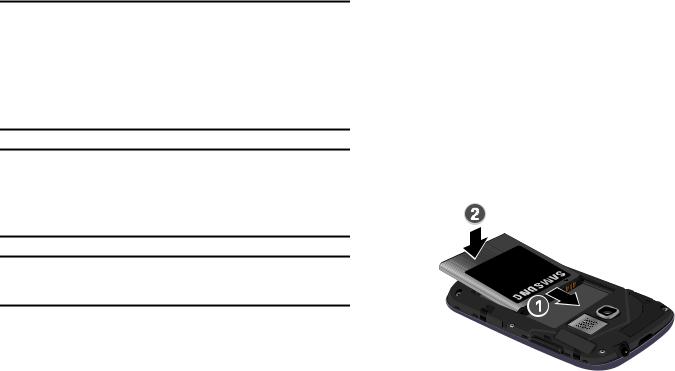
Battery
Your phone is powered by a rechargeable, standard Li-Ion battery. A Wall/USB Charger (Charging Head and USB cable) is included with the phone, for charging the battery.
Note: The battery comes partially charged. You must fully charge the battery before using your phone for the first time. A fully discharged battery requires up to 3 hours of charge time.
After the first charge, you can use the phone while charging.
Warning! Use only Samsung-approved charging devices and batteries. Samsung accessories are designed to maximize battery life. Using other accessories may invalidate your warranty and may cause damage.
Note: Failure to unplug the wall charger before you remove the battery, can cause damage to the phone.
Battery Indicator
The battery icon  in the Annunciator Line shows battery power level. Two to three minutes before the battery becomes too low to operate your phone, the empty battery icon will flash and a tone will sound. If you continue to operate the phone without charging the battery, the phone will power off.
in the Annunciator Line shows battery power level. Two to three minutes before the battery becomes too low to operate your phone, the empty battery icon will flash and a tone will sound. If you continue to operate the phone without charging the battery, the phone will power off.
Installing the Battery |
|
|
1. |
Remove the battery cover. (See |
“Removing the ba |
|
cover” on page 6.) |
|
2. |
Slide the battery into the compartment (1) so that the |
|
|
tabs on the end align with the slots at the bottom of the |
|
|
phone, making sure the connectors align. |
|
3. |
Gently press down to secure the battery (2). |
|
|
|
|
|
|
|
|
|
|
|
|
|
|
|
|
|
|
|
|
|
|
|
|
|
|
|
|
|
|
|
|
|
|
|
|
|
|
|
|
|
|
|
|
|
|
|
|
|
|
|
|
|
|
|
|
|
|
|
|
|
|
|
|
|
|
|
|
|
|
|
|
|
|
|
|
|
|
|
|
|
|
|
Getting Started |
9 |
||||

Removing the Battery
1.Remove the battery cover. (See cover” on page 6.)
2.Lift the battery up by the slot provided (1).
3. Lift the battery up and out of the phone (2).
10
Charging the Battery
“Removing the batteYouryphone is powered by a rechargeable Li-ion battery. A wall charger, which is used for charging the battery, is included with your phone. Use only approved batteries and chargers. Ask your local Samsung dealer for further details.
Before using your phone for the first time, you must fully
charge the battery. A discharg ed battery recharges full approximately 3 hours.
Note: Verify that the battery is installed prior to connecting the
wall charger. If both the wa ll charger is connected a the battery is not installed, the handset will power cycle continuously and prevent proper operation. Failure to
unplug the wall charger before you remove the battery, can cause the phone to become damaged.
Important!: It is recommended you fully charge the battery before using your device for the first time.
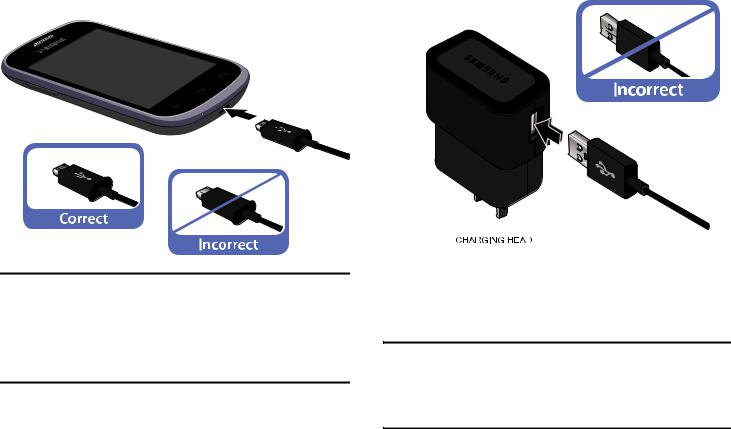
1.Insert the USB cable into the device’s Charger/ Accessory jack at the bottom of the device.
Note: This illustration displays both the correct and incorrect orientation for connecting the USB cable to the phone. If the USB cable is incorrectly connected, damage to the accessory port will occur, therefore voiding the phone’s warranty.
2. Connect the USB cable to the charging head.
3.Plug the charging head into a standard AC power outlet. The device turns on with the screen locked and indicates both its charge state and percent of charge.
Warning!: While the device is charging, if the touch screen does not function due to an unstable power supply, unplug the USB power adapter from the power outlet or unplug the USB cable from the device.
Getting Started |
11 |
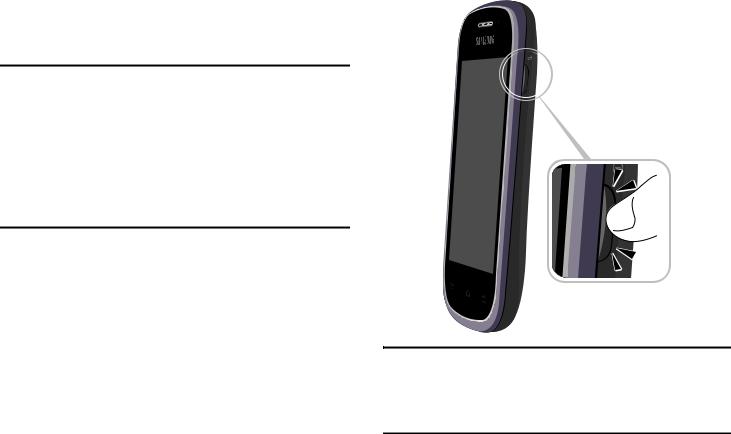
4. When charging is finished, first unplug the charger’s power plug from the AC wall outlet, then disconnect
the USB cable connector from the device.
Important! If your handset has a touch screen display, please note that a touch screen responds best to a light touch from the pad of your finger or a non-metallic stylus. Using excessive force or a metallic object when pressing on the touch screen may damage the tempered glass surface and void the warranty. For more information, refer to “Standard Limited Warranty” on page 145.
Turning Your Phone On
Press and hold the  Power/Lock key (on the upper right side of the phone) for three seconds.
Power/Lock key (on the upper right side of the phone) for three seconds.
While powering on, the phone connects with the network, then displays the Locked screen and any active Notification alerts.
Note: Your phone’s internal antenna is located along the bottom back of the phone. Do not block the antenna; doing so may affect call quality or cause the phone to operate at a higher power level than necessary.
12
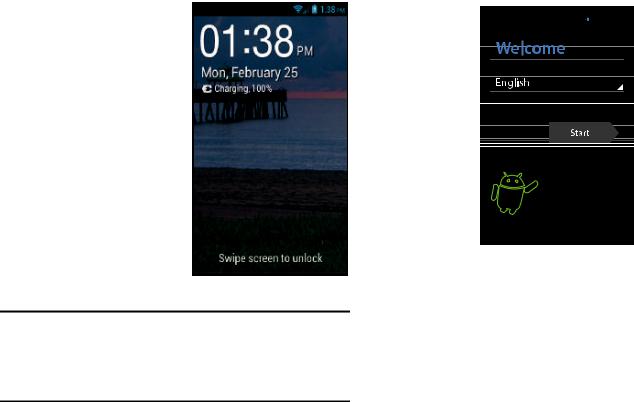
Unlocking Your Phone
1.If needed, press the
 Power/ Lock Key to wake the screen.
Power/ Lock Key to wake the screen.
2.If there are no Notification alerts on your phone, swipe the screen to unlock it. The Home screen appears.
Note: If you have purchased your phone online, the first time you power your phone on and unlock the screen, the Activation Wizard Welcome screen appears.
Follow the prompts to activate and setup your phone.
R

 2:33 PM
2:33 PM
 Emergency call
Emergency call
Turning Your Phone Off
1.Press and hold the  Power/Lock Key (on the upper right side of the device) for two seconds.
Power/Lock Key (on the upper right side of the device) for two seconds.
2.At the prompt, touch Power off. The Power off pop-up appears.
3.At the prompt, touch OK.
Getting Started |
13 |

Your Google Account
Your new phone uses your Google account to fully utilize its Android features, including Gmail, Google Maps, Google Talk, and the Google Play Store. When you turn on your phone for the first time, you should set up a connection with your existing Google account, or create a new Google account.
1.From the Make it Google screen, touch Sign in (if you already have a Google account) or Get an account (if you do not have a Google account).
– or –
Press  Home, then touch
Home, then touch  Apps, and the Apps tab, then touch
Apps, and the Apps tab, then touch  Gmail. The Add a Google Account screen displays. Touch Existing or New to continue.
Gmail. The Add a Google Account screen displays. Touch Existing or New to continue.
2.Follow the on-screen instructions to sign in if you already have a Google account, or to create a Google Account.
14
Resetting your Google Account Password
A Google account password is required for Google applications. If you misplace or forget your Google Account password, follow these instructions to reset it:
1.From your computer, use an Internet browser to navigate to google.com/accounts.
2.Once the Web Page loads, click on the Can’t access your account? link.
3.Under Having trouble signing in?, follow the password reset prompts.

TTY Mode
Your phone is fully TTY-compatible, allowing you to connect a TTY device to the phone’s headset jack. Before you can use your phone with a TTY device, you’ll need to enable TTY Mode.
(For more information, refer to “Other call settings” on page
50.)
Voicemail
All unanswered calls to your phone are sent to voicemail, even if your phone is turned off, so you’ll want to set up your voicemail and personal greeting as soon as you activate your
phone.
Setting up Voicemail
1.Press  Home, then touch
Home, then touch  Phone, then touch and hold
Phone, then touch and hold  .
.
2.Follow the automated instructions to set up your new password and record a greeting.
Checking Voicemail
1.Press  Home, then touch
Home, then touch  Phone, then touch and hold
Phone, then touch and hold  .
.
2.Follow the automated instructions to manage voicemail.
Tip: You can also access Voicemail by dialing your phone number from any touch-tone phone.
Displaying Your Phone Number
Press  Home, then touch
Home, then touch  System settings About phone Status.
System settings About phone Status.
Your phone number displays under My phone number.
Getting Started |
15 |

Roaming
When you travel outside your home network’s coverage area, your phone can roam to acquire service on other compatible digital networks. When Roaming is active, the Roaming icon ( ) appears in the Annunciator Line (Notification Bar) of the display.
) appears in the Annunciator Line (Notification Bar) of the display.
Tip: You can set your phone’s roaming behavior. (For more information, refer to “Mobile networks” on page 103.)
During roaming, some services may not be available. Depending on your coverage area and service plan, extra charges may apply when making or receiving calls.
Note: Contact your Wireless Provider for more information about your coverage area and service plan.
16
Securing Your Phone
By default, the phone locks automatically when the screen times out, or you can lock it manually. You can unlock the phone using one of the default Unlock screens, or for increased security, use a personal screen unlock pattern, a Personal Identification Number (PIN), or a password.
(For more information about creating and enabling a Screen unlock pattern, see “Screen lock” on page 110.)
Note: Unless stated otherwise, instructions in this User Manual start with the phone unlocked, at the Home screen.
Locking the phone manually
Press the  Power/Lock key on the top right side of the phone.
Power/Lock key on the top right side of the phone.
Unlocking the phone
For information on unlocking your phone, see “Unlocking
Your Phone” on page 13.
Unlocking with a Personal Screen Unlock Pattern
1.Press the  Power/Lock Key to wake the screen.
Power/Lock Key to wake the screen.
2.Draw your personal unlock pattern on the screen.
(For more information, refer to “Setting an Unlock Pattern” on page 111.)
Unlocking with a Password
1.Press the  Power/Lock Key to wake the screen.
Power/Lock Key to wake the screen.
2.Enter your Password.
3.Press OK.
Getting Started |
17 |

Section 2: Understanding Your Phone
Features
•3.5-inch (480x320 pixel) HVGA full-screen touch screen
•5-page Home screen, simplified main menu, and separate, 4-page Applications menu
•High Speed Data [EVDO 3G - Rev A Capable Technology]
•Android OS
•Motion and position sensitivity
•Play Store™, plus pre-loaded applications
•Connections
–Wi-Fi 802.11 b/g/n
–Wireless Modem Service
–Bluetooth 3.0 + EDR
–Virtual Private Network (VPN)
•Messaging Services (with on-screen QWERTY Keypads)
–Text Messaging
–Picture Messaging
–Video Messaging
–Voice Messaging
–Mobile Instant Messenger (IM)
–Chat
18
•Full-HTML Browser
•Global Positioning (GPS) Technology
•3.0 Megapixel CMOS Camera-Camcorder, rear-facing
•Picture Gallery, supporting JPG, PNG, GIF, and BMP formats
•Music Player, supporting MP3 format
•Video Player, supporting MP4, 3GP, 3G2, M4V, and WEBM formations
•Speakerphone
•Ringtone and Alert tone support for MP3, AAC, WMA, M4A, OGG, MID, and AMR formats
•Support for microSD™ and microSDHC™ Memory Cards (up to 32 GB capacity)
•Bluetooth® 3.0 + EDR Wireless Technology. (For more information, refer to “Bluetooth profiles” on page 97.)
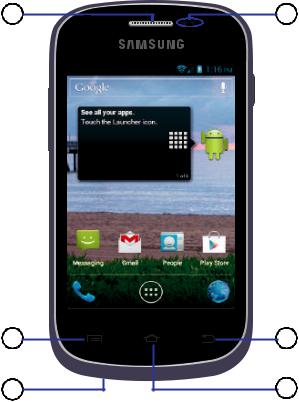
Front View
1.Earpiece: Use during calls to listen to callers.
2.Menu Key: Press to display options for the current screen.
3.Microphone: Use during calls to allow callers to hear your voice, and when recording.
4.Home Key: Press to display the Home screen, or Lock screen if the phone is locked. Press and hold to display recent applications.
5.Back Key: Press to return to the previous screen or option.
6.Proximity Sensor: Detect the presence of nearby objects to control device functions or blank the screen display, such as when you hold the phone to your ear during a phone call.
Understanding Your Phone |
19 |
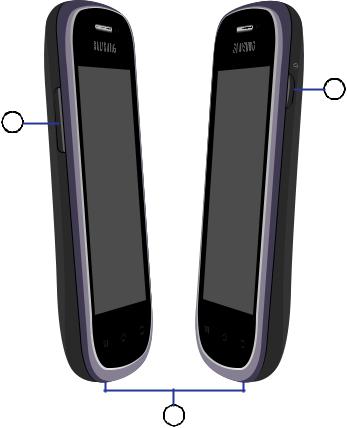
Side Views
20
1.Volume Key: From the Home screen, touch to adjust Master Volume. During calls or music playback, press to adjust volume. Press to mute the ringtone of an incoming call.
2.USB Power/Accessory Port: Connect a USB cable for charging or to sync music and files.
3.Power/Lock Key: Press and hold to turn the phone on or off. Press to lock the phone, or to wake the screen for unlocking.
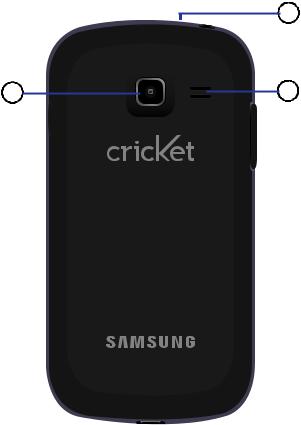
Back View
1.3 Megapixel Camera Lens: Use when taking photos or recording videos.
2.External Speaker: Play ringtones, call audio when in Speakerphone mode, media sounds (music and video), and other sounds.
3.3.5mm Headset Jack: Plug in an optional headset or TTY equipment.
Understanding Your Phone |
21 |

Navigation
Navigate your phone’s features using the command keys and the touch screen.
Warning! Please note that a touch screen responds best to a light touch from the pad of your finger or a nonmetallic stylus. Using excessive force or a metallic object when pressing on the touch screen may damage the tempered glass surface and void the warranty. (For more information, refer to “Warranty Information” on page 145.)
Context-sensitive Menus
While using your phone, context-sensitive menus offer options for the feature or screen currently in use.
To access context-sensitive menus:
•Touch  Menu.
Menu.
•Touch and hold on an item.
22
Command Keys
Menu Key
Touch  Menu to display a context-sensitive menu of
Menu to display a context-sensitive menu of
options for the current screen or feature.
Home Key
Touch  Home to display the Home screen.
Home to display the Home screen.
Touch and hold  Home to launch a menu of recent
Home to launch a menu of recent
applications.
Back Key
Touch  Back to return to the previous screen, option or step.
Back to return to the previous screen, option or step.
Finger Motions
Touch
Touch items to select or launch them. For example:
•Touch the on-screen keyboard to enter characters or text.
•Touch an item to select it.
•Touch an app’s icon to launch the application.
Touch and Hold
Activate on-screen items by a touch and hold gesture. For example:
•Touch and hold a widget or icon on the Home screen to move it.
•Touch and hold on a field to display a pop-up menu of options.
Swipe
Swipe your finger vertically or horizontally across the screen. For example:
•Unlocking the screen
•Scrolling the Home screen or a menu
•Combine touch and hold with swipe to drag an item to a new location.
Pinch
Using two fingers, make a pinch motion on the screen. For example:
•Pinch in to zoom in on pictures or screens.
•Pinch out to zoom out on pictures or screens.
Understanding Your Phone |
23 |
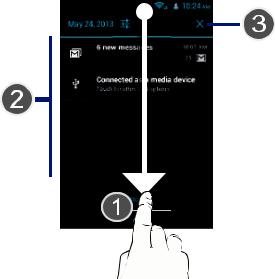
Notifications
Notifications shows information about connections, alerts and other items.
1.Touch and drag downward from the top of the screen to display notifications.
2.Touch an item to open that item, or to launch a related app or feature.
3.Touch X to clear all Notifications.
24
Clearing Notifications
1.Sweep your finger downward from the top of the screen to display Notifications.
2.Touch a notification to clear it, or to launch an app.
– or –
Touch X to clear all notifications.
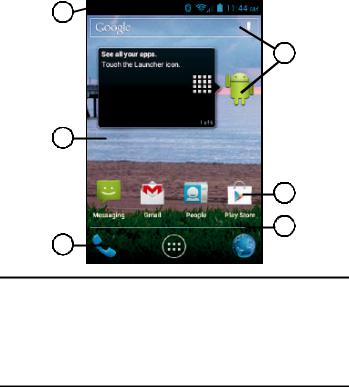
Home Screen
The Home screen is the starting point for using your phone.
Note: Unless stated otherwise, instructions in this User Manual start with the phone unlocked, at the Home screen.
All screen images in this manual are simulated. Actual displays may vary, depending on the software version of your phone and any changes to the phone’s Settings.
1.Status Bar: Presents icons to show network status, battery power, and connection details. (For a list of icons, see “Status Bar Icons” on page 26.)
2.Home screen: The starting point for using your phone. Place shortcut icons, widgets, and other items to customize your phone to your needs. (For more information, see “Home Screen” on page 25.)
3.Primary Shortcuts: Shortcuts to your phone’s common apps. (For more information, see “Primary Shortcuts” on page 29.)
4.Panel Indicator: Shows what panel of 5 available Home screen panels displays.
5.Shortcuts: Shortcuts to common apps. These shortcuts are found on the Home screen by default, and you can add more shortcuts to your favorite apps. (For more information, see “Shortcuts” on page 29.)
6.Widgets: Apps that run on the Home screen. These widgets are found on the Home screen by default, and you can add your favorites. (For more information, see “Widgets” on page 28.)
Understanding Your Phone |
25 |
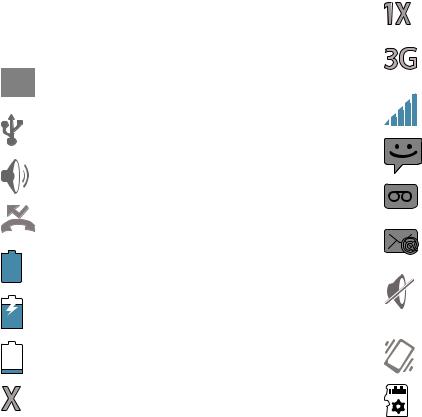
Status Bar Icons
The Status Bar shows network |
and battery status and other |
details.
Airplane Mode Active: All wireless communications are disabled. (See “Airplane mode” on page 100.)
USB Connected: The phone is connected to a computer using a USB cable.
Speakerphone: Speakerphone is enabled.
Missed Call: Displays when there is a missed call.
Battery Level: Shown fully charged.
Battery Charging: Battery is charging.
Device Power Critical: Battery has very little power remaining. Charge immediately.
No Network: No wireless network is available.
26
1X connection: Phone is active on a 1X system.
3G connection: Phone is active on a 3G system.
Signal Strength: Current signal strength. The greater the number of bars, the stronger the signal.
New Message: You have new message(s).
New Voicemail: You have new voicemail. A number indicates the number of new messages.
New Email Message: You have new email.
Silent mode: All sounds except media and alarms are silenced, and Vibrate is not active. (See “Volume” on page 103.)
Vibrate: All sounds are silenced, and Vibrate is active. (See “Vibrate and ring” on page 104.)
SD Card Being Prepared: A memory card scan is underway, to prepare the card for use.
